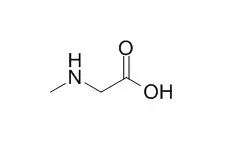| Structure Identification: |
| J Transl Med. 2014 May 28;12:149. | | Implications of differences in expression of sarcosine metabolism-related proteins according to the molecular subtype of breast cancer.[Pubmed: 24884785] | The goal of this study was to investigate the expression of Sarcosine metabolism-related proteins, namely glycine N-methyltransferase (GNMT), Sarcosine dehydrogenase (SARDH), and l-pipecolic acid oxidase (PIPOX), in the different breast cancer subtypes and to assess the implications of differences in expression pattern according to subtype.
METHODS AND RESULTS:
Sarcosine metabolism phenotype was stratified according to IHC results for GNMT, SARDH, and PIPOX: GNMT(+), SARDH and PIPOX(-) was classified as high Sarcosine type; GNMT(-), SARDH or PIPOX(-) as low Sarcosine type; GNMT(+), SARDH or PIPOX(+) as intermediate Sarcosine type, and GNMT(-), SARDH and PIPOX(-) as null type. Expression of Sarcosine metabolism-related proteins differed significantly according to breast cancer subtype (GNMT, p=0.005; SARDH, p=0.012; tumoral PIPOX, p=0.008; stromal PIPOX, p<0.001). These proteins were the most frequently expressed in HER-2 type tumors and the least in TNBC. Sarcosine metabolism phenotype also varied according to breast cancer subtype, with high Sarcosine type the most common in HER-2, and null type the most common in TNBC (p=0.003). Univariate analysis revealed that GNMT expression (p=0.042), tumoral PIPOX negativity (p=0.039), and high Sarcosine type (p=0.021) were associated with shorter disease-free survival (DFS). Multivariate analysis also revealed GNMT expression was an independent factor for shorter DFS (hazard ratio: 2.408, 95% CI: 1.154-5.024, p=0.019).
CONCLUSIONS:
Expressions of Sarcosine metabolism-related proteins varied according to subtype of breast cancer, with HER-2 type tumors showing elevated expression of these proteins, and TNBC subtype showing decreased expression of these proteins. Expression of Sarcosine metabolism-related proteins was also associated with breast cancer prognosis. |
|






 Cell. 2018 Jan 11;172(1-2):249-261.e12. doi: 10.1016/j.cell.2017.12.019.IF=36.216(2019)
Cell. 2018 Jan 11;172(1-2):249-261.e12. doi: 10.1016/j.cell.2017.12.019.IF=36.216(2019) Cell Metab. 2020 Mar 3;31(3):534-548.e5. doi: 10.1016/j.cmet.2020.01.002.IF=22.415(2019)
Cell Metab. 2020 Mar 3;31(3):534-548.e5. doi: 10.1016/j.cmet.2020.01.002.IF=22.415(2019) Mol Cell. 2017 Nov 16;68(4):673-685.e6. doi: 10.1016/j.molcel.2017.10.022.IF=14.548(2019)
Mol Cell. 2017 Nov 16;68(4):673-685.e6. doi: 10.1016/j.molcel.2017.10.022.IF=14.548(2019)